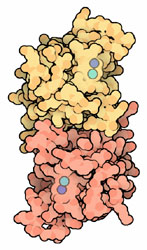|
Inhaltsübersicht | Nanomaschinen | Moleküle | Programme | Kurse | Fun | Links |
||
| > |
Superoxide Dismutase

We can't live without oxygen. Our cells rely on oxygen as the final acceptor of electrons in respiration, allowing us to extract far more energy from food than would be possible without oxygen. But oxygen is also a dangerous compound. Reactive forms of oxygen, such as superoxide (oxygen with an extra electron), leak from the respiratory enzymes and wreak havoc on the cell. This superoxide can then cause mutations in DNA or attack enzymes that make amino acids and other essential molecules. This is a significant problem: one study showed that for every 10,000 electrons transferred down the respiratory pathway in Escherichia coli cells, about 3 electrons end up on superoxide instead of the proper place. To combat this potential danger, most cells make superoxide dismutase (SOD, shown here from PDB entry 2sod), an enzyme that detoxifies superoxide.
Dismutation
As you might guess from its name, SOD dismutes superoxide. Dismutation is a term that refers to a special type of reaction, where two equal but opposite reactions occur on two separate molecules. SOD takes two molecules of superoxide, strips the extra electron off of one, and places it on the other. So, one ends up with an electron less, forming normal oxygen, and the other ends up with an extra electron. The one with the extra electron then rapidly picks up two hydrogen ions to form hydrogen peroxide. Of course, hydrogen peroxide is also a dangerous compound, so the cell must use the enzyme catalase to detoxify it.
SOD in the Clinic
SOD has recently gained notoriety for its connection with amyotrophic lateral sclerosis, more commonly known as Lou Gehrig's disease. This disease is a degenerative disorder that leads to selective death of neurons in the brain and spinal chord, leading to gradually increasing paralysis over a few years. Most cases mysteriously appear in later life, with unknown cause. But about a tenth of cases are hereditary, caused by mutations that may be inherited from parents. Recent research has shown that one of the mutations is found in the gene for SOD. Scientists are now studying the role of SOD in the disease, hoping that this knowledge will lead to new treatments and cures.
Last changed by: A.Honegger,